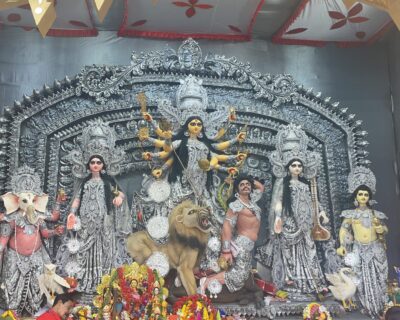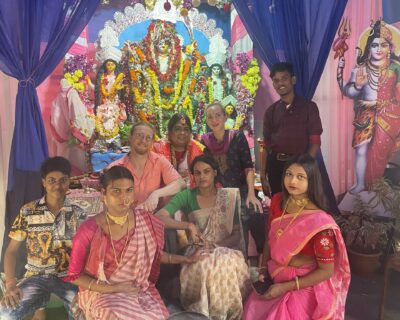Phil Lagace’s travel blog from India
For those that missed my introductory piece in a prior newsletter, my name is Phil Lagace, I teach at Dawson through the Religion Department, and I’ll be providing updates on my doctoral research as I travel India with my partner Aurélie. A week ago, we landed in Kolkata for its massive Durgā Pūjā festival. The goddess Durgā is a central deity in the Śakta branch of Hinduism; Śakta tra

ditions hold the Goddess, referred to as Śakti or Devī, as supreme. This divine feminine principle is understood to manifest in various forms. Durgā is popularly recognized as preeminent among these, particularly in the region of West Bengal (including Kolkata, its capital). Durgā is commonly depicted with eight or more arms, each wielding a weapon given to her in order to fight the forces of evil. She is shown with her lion or tiger vāhana (vehicle mount), often attacking Mahiṣa, a shapeshifting demon she famously defeats in battle; Durgā Pūjā celebrates this event.
Central to public celebrations of Durgā Pūjā are its paṇḍāls, temporary temple structures erected in the thousands for the festivities. Generally, each paṇḍāl contains a sculptural image of the goddess Durgā subduing Mahiṣa while flanked by her children: gods Gaṇeśa and Kārttikēya, and goddesses Lakṣmī and Sarasvatī. However, this barebones framework is nowadays brought to life with extravagance. These paṇḍāls and the deities within are fashioned with wild creativity.
Some paṇḍāls may be Hogwarts-themed, constructed out of recycled toothbrushes, resemble UFOs, modelled after the Vatican, etc. Festivalgoers undertake “paṇḍāl-hopping,” travelling from one compelling installation to the next. Moreover, the paṇḍāl figures may be fashioned in the likeness of public personalities. For example, the demon Mahiṣa was once depicted as Bill Clinton in the aftermath of his sex scandal. Tacit here is the implication that paṇḍāls also serve as platforms to showcase religious, social, and political commentary. This year, one paṇḍāl related to my research depicts Durgā as Ardhanārīśvara (a half-male, half-female figure); it was constructed by a community of transgender people and calls for the inclusion of those marginalized for their sexual orientation and/or gender identity. Stay tuned for more updates, and please enjoy the images of this year’s Durgā Pūjā installations.




